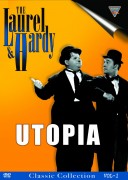|
LITR 5439 |
Literary & Historical Utopias: Model Assignments
Sample Essay 1 & 2 |
|
Amy Shanks
A Utopian Education
(Prompt
A3 & Essay 2 Combined
Dystopian literature is generally
regarded as having a greater entertaining value than utopian works (Obj. 1a). A
utopian tale is commonly devoid of conflict, deviating from the traditional plot
structure fiction is built upon. Because there is usually a heightened sense of
community, utopian literature often lacks diverse, well-developed characters and
instead has one or two characters representative of the collective (Looking
Backward’s Dr. Leete and Utopia’s Raphael Hythloday). These
aberrant characteristics are often the reason why dystopian literature is
prioritized in high school curriculum; however, there is a close relationship
between the two genres that mandates paired teaching. To completely dismiss
utopian literature is an insult to the genre and a disservice to students.
A common
concern for teaching utopian literature is that it is not entertaining enough to
engage students (Obj. 5c). Conflict is a reality of life that can unfortunately
thrive in high school settings (Obj. 2a-2c). Even if students have no personal
investment in the occasional fights that break out, there is almost always a
natural curiosity for details. This unpleasant morbid curiosity drives most
fiction plots, including dystopian literature. Conflict is often considered the
“entertaining” aspect of a storyline, implying a harmonic existence can make for
a boring read.
From
Animal Farm to
Lord of the Flies, the most common
dystopian titles in current high school curriculum place heavy emphasis on
conflict that often leads to violence. This plot point is usually left out of
utopian literature, however, often leading to the hesitation to incorporate the
genre into curriculum. With
community being the elevated ideal, most utopian plotlines in the course
readings have focused on how people work together rather than against one
another. With an amplified example of “it takes a village” to raise children,
Charlotte Perkins Gilman’s Herland
articulates the communal mindset of childrearing through Moadine’s statement:
“Because the finished product is not a private one” (59).
It is only natural that conflict would not thrive in such a communal
environment where the concept of the “family unit” becomes so extended. The only
utopian course reading selection that truly exemplified conflict was Ernest
Collenbach’s Ecotopia. From the
lovers’ quarreling outside of William’s corridors to the “cooperative criticism”
at the cafe, it extended the characteristics of the genre by depicting utopian
characters with a greater range of emotions. However,
Ecotopia is not the norm for utopian
literature and due to its salacious content it would not be appropriate for high
school curriculum.
Conflict is
not the only plot device that captivates readers, however. Though the stories
are not driven by the explosive products of discord, utopian literature has more
subtle means of engagement that beckons readers to delve into comparative
elements of real life and literature – an element lacking in some dystopian
literature. Utopian tales are often deemed incredulous because of the ideals
they purport, but this most chastised characteristic is what makes the genre so
engaging (obj. 3). In order to articulate such a scathing critique, a reader
must evaluate the text. Utopias force us to consider their purpose and compare
it with our realty to determine whether or not we are convinced. It is almost
inescapable to juxtapose the familiar characteristics of child behavior from
personal experience when gauging the conceivability of Ecotopian children
achieving “an intuitive feeling for the fact that people excel in different
things, and that they can give to each other on many different levels” (119).
In contrast, dystopian societies are easier to accept in part because of
rampant pessimism throughout society. From natural disasters to immanent
terrorist attacks, Armageddon always seems to be on its way. Therefore, willing
suspension of disbelief is much more likely to be used while reading a dystopian
work, which allows a reader to simply take in the events of a story rather than
interactively engage with it.
Utopian
literature is also often criticized for lacking relatable settings and developed
characters (Obj. 1a). During the day, high school students’ lives are highly
controlled. A stark contrast from the lax educational approaches exemplified in
Ecotopia, the American education
system relies heavily on structure. From the clothes they are permitted to wear
to the classes they are enforced to take, students have very little control over
their day-to-day routines. Once the students get home, the school day does not
(or should not) stop. Usually loaded down by nightly homework, students’ time is
heavily directed by the demands of school. Though this controlling environment
is purposefully created to instill discipline and knowledge within the students,
this intention is not always realized within the “oppressed” students.
A desire to break free from a controlling entity is a thematic element to
a dystopian setting that students can often easily relate to.
It is not difficult to picture students identifying with
Anthem’s Equality 7-2521 when he
expresses the defiantly emphatic desire to “be away from the City and the air
that touches upon the air of the City” (24). In contrast, they are much more
likely to feel leery toward the conformity elements of a utopian community
setting. Students are likely to feel unsettled by the “Great Trust” described in
Edward Bellemy’s Looking Backward. As
Kristin Bird astutely observed in her 2007 final exam, this construct of the
utopia implies that the “individual
no longer matters unless it is part of the whole”
(http://coursesite.uhcl.edu/hsh/Whitec/LITR/5439utopia/models/finals/f2007/final07bird.htm).
Dystopian
literature generally has the advantage with these literary elements. The
unadulterated joy that members of utopian societies experience is not likely
something that teenagers readily relate to. While high schools are not
completely devoid of voracious readers, it is unlikely that any student would be
able to connect with the content of any publication in the utopian manner that
Frederick Douglass expresses in Narrative
of the Life of Frederick Douglass when he states
“the paper became my meat and my drink. My soul was set on fire” (Ch. 11).
However, that does not mean utopian characters (or autobiographical utopian
experiences) are completely impossible to relate to. Utopian texts usually
feature an outsider role that often connects with adolescence. Students could
just as easily relate to Herland, in
which Jeff, Van (and yes, even Terry’s) curiosity to learn more about the
inhabitants and their struggle to build relationships with people of a different
culture.
From
differing socioeconomics to varying cultural backgrounds, most public school
classrooms are filled with diverse demographics. The modern classroom experience
can often be analogous to the culture shock that comes from the utopian journey
motif because students are frequently affronted with elements of cultures and
beliefs they had never been exposed to before. Because education trends
emphasize cooperative learning, from the very first day of class students are
arbitrarily placed together with the expectation that they demonstrate
tolerance, collaboration, and respect. Students are not required to completely
eradicate the concept of individuality as in
Anthem, but they are expected to find
a way to work together regardless of differing opinions.
Ultimately,
the best approach to the dystopian/utopian debate is to recognize what both
genres have to offer and format a well-developed curriculum that showcases them
together. Olaudah Equiano’s The
Interesting Narrative of the Life of Olaudah Equiano is an example of a text
that could achieve this goal. The utopian elements of the African homeland where
the “land is uncommonly rich and fruitful” and the community is “remarkably
cheerful” (Ch. 1) are emphasized by the stark contrasting dystopian elements of
slavery where “the loathsomeness of the stench and crying together” (Ch. 2)
steals the appetite for food and life itself. With strategic planning, an
integrative approach for teaching the genres has the best potential for
conceptualizing their unique and similar constructs.
Both of my
research postings emphasized practical application to my occupation (Obj. 5c).
The natural extension of this assignment is a plan for implementation.
I am lucky enough to work in a district where there is flexibility in
text selection and a strong emphasis on teaching literature through genres. What
I discovered from the second research posting was a common recommendation for
teaching dystopias and utopians comparatively.
While I would agree with the general consensus from class discussion that our
graduate course text selection was not necessarily targeted for high school
students, Paul Wild’s article from my posting relayed such positive results it
encouraged me to see if I could make the texts work.
Though it is
still difficult to picture students enthralled in the diatribes of Raphael in
More’s Utopia or inspired by the
almost incredulous perfection delineated the by Dr. Leete in Bellemy’s
Looking Backward, using excerpts from
both novels is a manageable approach for an adolescent audience.
My plan for
introducing the topic is also the foundational guideline for the entire unit. I
will begin with a student exploration of what they know and recognize about the
conventions of the genres before delving into the literature. Though in my
research posting I expressed hesitation toward some of the educational
activities from John Knapp’s article, his emphasis on explorative learning is an
excellent educational approach I plan to extend.
Good literature studies encourage students to reflect, relate, and compare the
text with their surroundings. In an attempt to foster such a student-text
relationship, my utopian/dystopian unit will begin with an analysis of our
school environment.
Members of
the community have jokingly referred to the school where I am employed as “the
compound.” Its proper title, “The Education Village,” perhaps better conveys its
strategic purpose. In contrast to
the typical sprawling elementary, intermediate, and high school campuses most
districts create, the school decided to plot all three campuses together for a
specific goal: to foster a sense of community throughout the entire student
body. Identifying the utopian ideology embedded within the community in which
the students are already a member is a strategic method of explorative learning.
I plan to use this activity as a foundational reference point to guide the
class’s “journey” through the comparative genre unit.
As
previously mentioned in the midterm essay, my introduction to utopian literature
was a little bumpy, but I am exhilarated by the moments of mental struggle
because of where they led me. What
I appreciate the most from this course is the refreshing excitement I now have
for incorporating what I have learned into my professional classroom. For me,
the biggest challenge in my profession is not the student engagement,
administrative expectations, nor the insurmountable grading, but it is simply
the lack of time to generate (and at times even to develop enthusiasm for)
lessons that all of these pressures of education cause.
Taking summer courses that have provided me with materials to work with
next year was the most rewarding way to use my vacation time.


